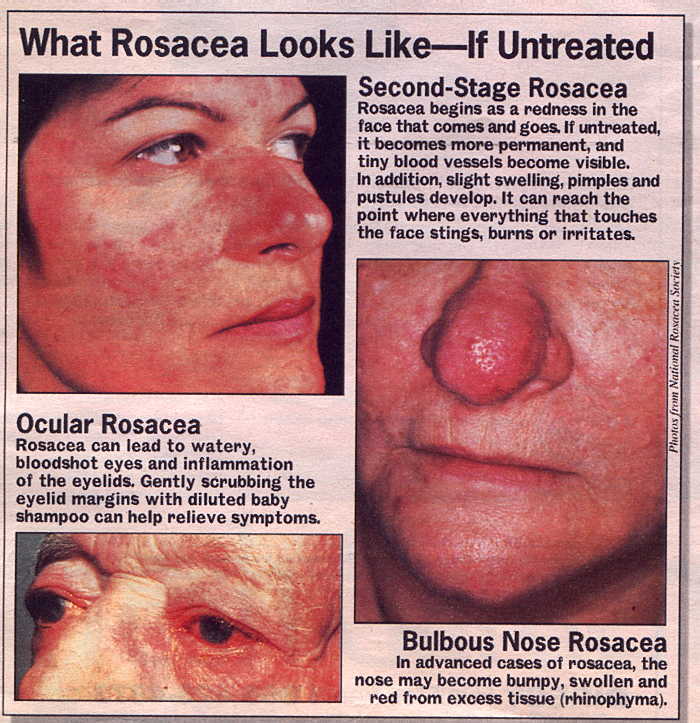Rosacea
Symptoms
Home remedies
- According to Ayurvedic tradition, someone with a pitta imbalance is considered to have a hot body and internal temperature, so a diet of cool, sweet, stabilizing foods should replace those that are salty, sour, spicy, or pungent.
- Feverfew (Tanacetum parthenium): One of the primary active components of feverfew, parthenolide, inhibits serotonin release from platelets. Feverfew inhibits 5-lipoxygenase and cyclooxygenase, resulting in a reduction in human blood platelet aggregation.In a recent study by Martin and associates, 45 days of treatment with 1% feverfew PFE (parthenolide-free extract) – Aveeno Daily Moisturizer Ultracalming, improved mild inflammatory acne by inhibiting the release of inflammatory markers from activated lymphocytes and reducing neutrophil chemotaxis. It is these immunomodulating properties that suggest feverfew PFE[TM] may be a useful treatment for rosacea.
- Green Tea (Camellia sinensis): The green tea derivatives epicatechin, epigallocatechin, epicatechin-3-gallate, and epigallocatechin-3-gallate possess well-documented anticarcinogenic properties and anti-inflammatory and antioxidant capabilities. These properties are especially useful for patients with rosacea as inherent sun sensitivity is a hallmark of the disease. The photoprotective properties of green tea may lessen reactivity to ultraviolet light, thereby reducing the signs and symptoms of rosacea. Moreover, green tea extract has been shown to reduce the disruption of the skin barrier often seen in patients with the disease.
- Oatmeal : First, oatmeal is a potent antipruritic. The moisturizing properties of colloidal oatmeal alleviate itch due to dry skin. These properties, in turn, promote protection of barrier function, which is often impaired in rosacea patients. Oatmeal also works as a skin protectant and enhancer of barrier function as the proteins and polysaccharides bind to skin to provide a protective barrier, while proteins buffer both acids and bases.
- Licorice (Glycyrrhizin):Glycyrrhizinic acid has also been shown to improve dermatitis. In a study by Saeedi and associates, 2% glycyrrhizinic acid gel was reported to significantly decrease scores for erythema, edema, and itching over the 2-week treatment period.A recent study by Dieck and associates found that licochalcone A exhibited a potent anti-inflammatory action on a broad range of skin cells involved in skin inflammation.
- Lavender (genus Lavandula): studies in animal models confirm the traditional use of Lavandula angustifolia for the treatment of painful and inflammatory conditions (including gastrointestinal disorders, migraines, and generalized pain).
- Chamomile (Matricaria recutita and Chamaemelum nobile)The active constituents of chamomile include the terpenoids (bisoprolol, matricin, chamazulene) and flavonoids (apigenin, luteolin). Studies have documented the anti-inflammatory and soothing effects of creams containing chamomile in patients with various inflammatory dermatoses. Chamomile is used in a variety of cosmetic products and as soothing compresses.
- Tea tree oil (Melaleuca alternifolia): In recent years it has become increasingly popular as an antimicrobial agent and has also been demonstrated to possess anti-inflammatory properties. Tea tree oil should be used with caution, however, as it has been associated with a wide variety of side effects including allergic contact dermatitis, systemic contact dermatitis, erythema, and systemic hypersensitivity reactions as well as conditions such as linear immunoglobulin A disease.
- Camphor Oil (Cinnamonum camphora) : Recently, camphor oil has been evaluated for its efficacy in treating the demodicoses that are frequently comorbid with rosacea. In a study by Morsy, marked reduction in the infestation density were noted following application of diluted camphor oil at concentrations of 20% to 25%. Caution is warranted with the use of camphor oil, however, as it is a known skin irritant.
- http://rosacea-support.org/treating-rosacea-with-herbs.html
- Sulfur : Topically applied sulfur may help treat rosacea.
- Chrysanthellum Indicum Cream
- Niacinamide Cream : A form of vitamin B3, niacinamide may aid in the treatment of rosacea when applied directly to the skin.
- Azelaic Acid Cream : A substance derived from wheat, rye, and barley, azelaic acid is thought to alleviate skin redness and reduce rosacea-related papules and pustules when applied to the skin.
- Anti-inflammatory Diet : Research shows that inflammation plays a key role in the development of rosacea. Therefore, many practitioners of alternative medicine recommend following an anti-inflammatory diet to reduce rosacea symptoms.
- Addressing Food Intolerances : Since certain foods are thought to trigger the release of chemicals that dilate blood vessels and cause flushing, some practitioners of alternative medicine recommend avoiding these foods in order to reduce rosacea symptoms.
- Stress Management : Because stress is considered a common trigger for rosacea flare-ups, stress management techniques may help keep rosacea in check.
Warnings
The therapeutic value of medicinal herbs has gained increased acceptance by the medical profession. However, there are a number of variables which can influence the composition, concentration, and bioavailability of the herbal compound. Moreover, few of these ingredients have been evaluated in clinical trials. Despite these issues, many patients may benefit from the use of herbal remedies and a growing number of patients are using “natural” ingredients to treat their rosacea. Some have proven effects, many have potential benefits, and some may, in fact, aggravate rosacea. Of particular concern is the finding that patients using alternative therapies are unlikely to tell their doctor. Dermatologists should be aware of what patients are using and be able to advise them, beyond what is prescribed or the procedures performed. http://rosacea-support.org/treating-rosacea-with-herbs.html
References
Medical Disclaimer
This information is not meant to be substituted for medical advice. Always consult a medical professional regarding any medical problems and before undertaking any treatment or dietary changes.
